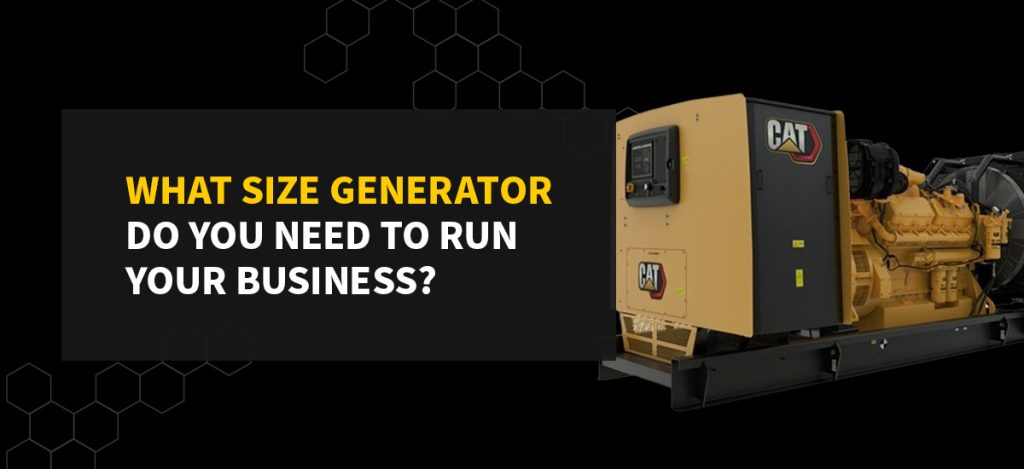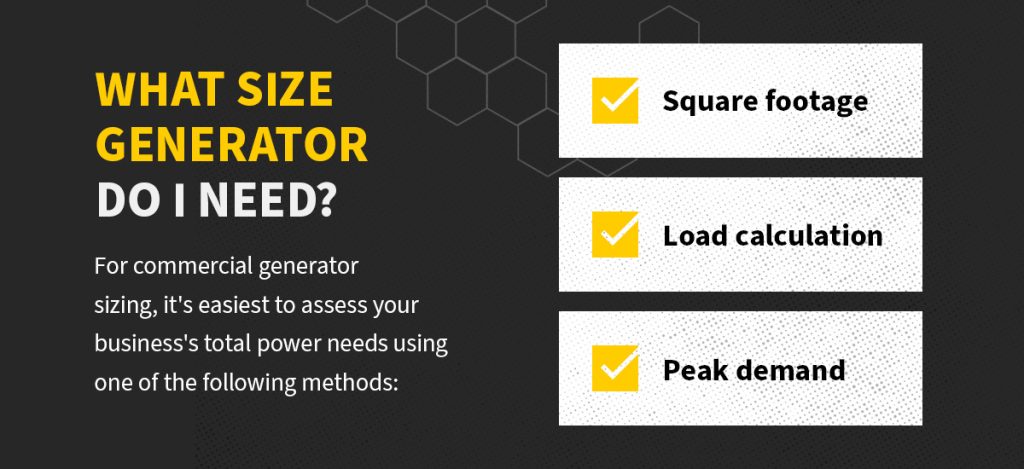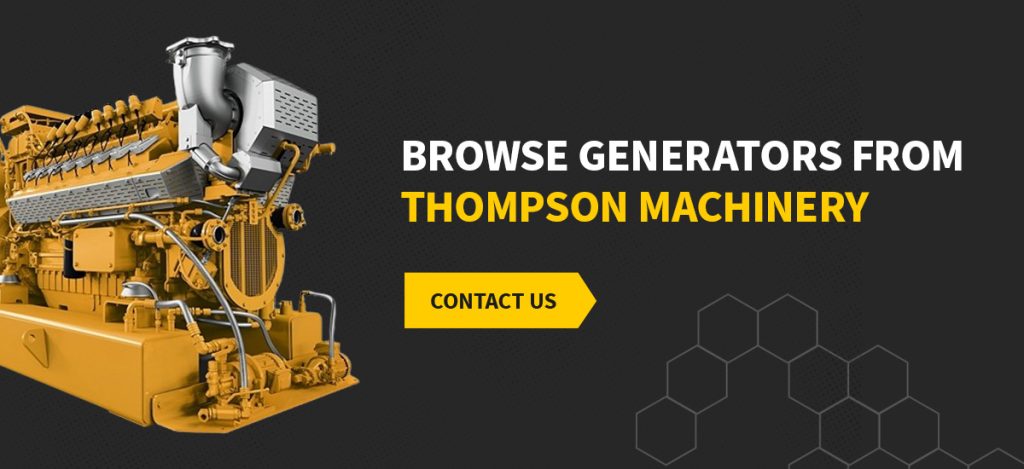
Choosing the right size generator is vital for dependable, efficient power generation. The right unit delivers the power you need without overheating, damaging your electrical systems or costing you excess money.
Find the ideal generator by calculating your facility’s peak energy consumption and consulting a professional power system dealer.
3 Types of Generators Available
The first step in choosing a generator is determining what type you need. The following types serve different applications and industries:
- Commercial: A commercial generator can handle the demands of commercial applications, such as lighting, HVAC equipment, retail operations and office equipment.
- Industrial: These models support heavy-duty applications for large-scale operations such as construction, manufacturing and healthcare facilities.
- Standby: Standby generators provide backup power in an outage. While commercial and industrial generators serve continuous or prime power needs, a standby generator is designed to automatically activate when a facility’s main power source fails. Standby generators are vital for supporting 24/7 operations, avoiding downtime and preventing data loss.
Importance of Proper Generator Sizing
A generator powers critical operations, and choosing a unit that fits your facility’s specific power needs is important. Sizing to meet your precise applications helps ensure you have a reliable, efficient power source.
A generator that’s too large for your application can potentially damage your electrical systems, reduce power production efficiency and result in unnecessary energy expenses. A unit that’s too small may deliver insufficient power, overheat or cause critical systems to fail.
How to Size a Generator
To size a generator, you must understand your power requirements. Create a list of all electrical systems and equipment your facility relies on. These may include the following:
- Iluminación
- Telecommunications
- Computer systems and data servers
- Safety and security systems
- HVAC systems
- Refrigeration solutions
- Heavy equipment vital for operations
- Payment terminals
Determine if you need single-phase or three-phase power. Most businesses require three-phase power to support larger loads for large-scale or industrial applications. However, single-phase power may be suitable if you run a small operation with limited power requirements.
Measure Power Consumption
To size your generator, you need to assess your equipment and system’s power demands. You can measure energy consumption in the following ways:
- Power monitoring sensor: Attach a power monitoring sensor, such as a clamp-on ammeter, to an electrical circuit’s wire to measure the current that flows through it. Measure the amperage when a piece of equipment or system starts and the amperage during peak operation. Repeat for each system and piece of equipment your generator needs to power.
- Electric meters: To monitor energy consumption, you can install electric meters at your main electrical distribution points, such as circuit breakers and electrical panels. Electric meters measure how much electricity each appliance, piece of equipment or circuit consumes. This method is known as submetering.
- Historical full load capacity: You can also measure your facility’s power consumption based on past peak demand. Review your utility bills over the past year and identify the peak demand.
Convert Amps to Watts or Kilowatts
You must know the watts or kilowatts your facility consumes to determine the size generator you need. To convert amps to watts (W), you can multiply amperage (A) by voltage (V) using this formula: A x V = W. To determine your power consumption in kilowatts, divide the wattage amount by 1,000.
What Size Generator Do I Need?
For commercial generator sizing, it’s easiest to assess your business’s total power needs using one of the following methods:
- Square footage: Calculate your base load and factor in your facility’s watts per square foot (WPSF). To calculate WPSF for a retail space, multiply your total square footage by 10 watts. For other commercial applications, multiply the total square footage by 5 watts.
- Load calculation: List your essential equipment and systems with their power requirements in kilowatts or watts. Add these figures to calculate your total load.
- Peak demand: Use your facility’s past energy bills to estimate your highest energy consumption during peak hours.
Choose a generator with a 10% to 20% higher capacity than your estimated peak power consumption to prevent overloading.
Industrial Generator Sizing
You will likely need a generator with three-phase power for industrial applications. Perform a detailed load analysis to determine your facility’s load requirements, including all of your machinery and systems.
Determine each piece of equipment’s starting and operating wattage and then calculate the total. Once you have this number, pick a generator with a 10% to 20% higher power capacity than your calculated total.
Standby Generator Sizing
Identify the critical systems and equipment you need to power during an outage to size a standby generator. Calculate your total power requirement by adding each system or piece of equipment’s starting and running wattages. Again, include a 10% to 20% buffer for potential equipment failures and surge capacities.
5 Tips for Selecting a Generator
The following additional tips can help you get the right generator for your business.
1. Consider Future Needs
You may need to accommodate higher power needs in the future if you plan to expand your business. As a growing company, consider what types of appliances, equipment or square footage you may add to your facility. Factor these into your decision and opt for a generator with a slightly higher power capacity if necessary.
2. Determine Ongoing or Temporary Power Needs
A permanent generator is only necessary if you need ongoing power generation. A portable generator is the best option if you need temporary power for an application such as construction work or a special event. You can rent generators for temporary projects and events, giving you the power you need without a permanent installation.
3. Seek Professional Advice
You don’t have to determine your ideal generator size on your own. Ask a professional for sizing assistance to ensure you make the right decision. When you talk to an experienced generator dealer or rental company, they can help you determine the right size based on your facility’s calculated power needs.
4. Follow Local Regulations
Some areas regulate generator installation. Check if you need to follow any local codes regarding power generation systems. This precaution helps you avoid paying unexpected fines.
5. Practice Safe Generator Use
Learn how to use a generator safely before installation. The Occupational Safety and Health Administration (OSHA) provides essential safety regulations to help you prevent accidents and injuries related to power generation equipment.
Browse Generators from Thompson Machinery
The generator you choose plays a significant role in your business. You depend on it to power your facility’s vital operations, and the right size helps ensure efficiency and dependability.
Thompson Machinery is dedicated to helping you choose a generator you can rely on. Browse our wide selection of Cat® generators or rental options, and contact us to learn more about selecting the right solution for your facility.





